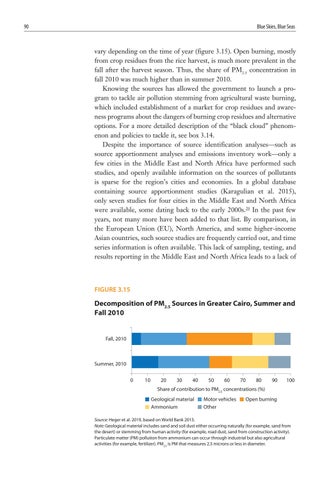90
Blue Skies, Blue Seas
vary depending on the time of year (figure 3.15). Open burning, mostly from crop residues from the rice harvest, is much more prevalent in the fall after the harvest season. Thus, the share of PM2.5 concentration in fall 2010 was much higher than in summer 2010. Knowing the sources has allowed the government to launch a program to tackle air pollution stemming from agricultural waste burning, which included establishment of a market for crop residues and awareness programs about the dangers of burning crop residues and alternative options. For a more detailed description of the “black cloud” phenomenon and policies to tackle it, see box 3.14. Despite the importance of source identification analyses—such as source apportionment analyses and emissions inventory work—only a few cities in the Middle East and North Africa have performed such studies, and openly available information on the sources of pollutants is sparse for the region’s cities and economies. In a global database containing source apportionment studies (Karagulian et al. 2015), only seven studies for four cities in the Middle East and North Africa were available, some dating back to the early 2000s.20 In the past few years, not many more have been added to that list. By comparison, in the European Union (EU), North America, and some higher-income Asian countries, such source studies are frequently carried out, and time series information is often available. This lack of sampling, testing, and results reporting in the Middle East and North Africa leads to a lack of
FIGURE 3.15
Decomposition of PM2.5 Sources in Greater Cairo, Summer and Fall 2010
Fall, 2010
Summer, 2010 0
10
20
30
40
50
60
70
80
90
100
Share of contribution to PM2.5 concentrations (%) Geological material Ammonium
Motor vehicles Other
Open burning
Source: Heger et al. 2019, based on World Bank 2013. Note: Geological material includes sand and soil dust either occurring naturally (for example, sand from the desert) or stemming from human activity (for example, road dust, sand from construction activity). Particulate matter (PM) pollution from ammonium can occur through industrial but also agricultural activities (for example, fertilizer). PM2.5 is PM that measures 2.5 microns or less in diameter.






